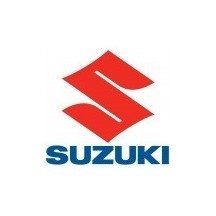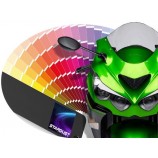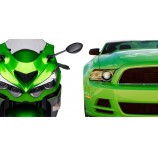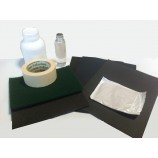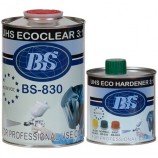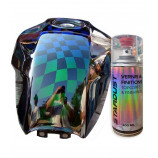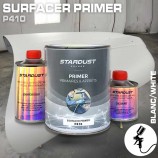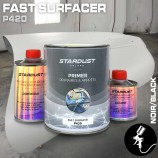Do you own a Suzuki motorcycle and have you decided to give your paintwork a facelift ? On this page you can find the paints made exactly according to all the color codes of Asian motorcycles and especially the color codes of Suzuki motorcycles, in different formats, including aerosols or paint pots (250ml to 2 Liters).
These are professional solvent-based paints. All colors are prepared by our colorists according to a Suzuki color code and a formula that we find in our colorimetry software.
=>To place the order online, you will simply need to know your paint reference and tell us after ordering by e-mail.
To determine how much Suzuki paint to order, all you need to do is know the approximate surface area of the part or set of fairings you want to repaint. We can start from the basic rule that 500 ml cover a maximum of 2 m².
This type of motorcycle paint is similar to automotive body paints. It is a particular system which consists of 2 stages : painting followed by clearcoat. From this system derives the name of the paint “two-layer paint”. In the terminology of the world of paint, these paints are also called “flat basecoats to be varnished”. They have the main characteristic of being ready to use, that is to say that they require no mixing, no addition of hardener. Only the pure versions may require the addition of a thinner in order to thin them. These paints are extremely easy to apply, even for amateur painters: they avoid the risk of dripping thanks to their finesse and instant drying. They also allow perfect placement of the pigments (pearl and aluminum) contained in all modern paints.
The ancillary products you will need can be primers* and also clearcoat.
The clearcoat is a necessary product for all matt or two-coat base paints, because it is what will provide resistance and shine.
Suzuki motorcycle color codes
Since the 1990s and 2000s, most of the brand's colors have been made up of mother-of-pearl and metallic pigments. These are sophisticated colors, with lots of shine and depth. It often happens that these colors require a 3rd coat, which takes the form of a specific undercoat : in such a case, this type of color is called a “tricoat” paint. It is then necessary to order, not two products (paint plus clearcoat), but three products.
You can find out if your paint is a "specific paint" by contacting our technical department. In any case, you don't have to worry about this, because when ordering, if a specific underlay is needed, then our preparer will contact you by phone, to tell you which additional product to order.
Among the color codes of the Suzuki brand, it is common that a certain primer is necessary before applying the paint. Suzuki paints are more or less covering, because the pearls are naturally semi-opaque. If you use a grey, black or white for the background color, you are likely to get a different final color. Here too, our technician will be able to give you precise recommendations concerning the primer to choose.
A primer is not just necessary to create an adequate color base coat. It also allows to perfect the surface before painting. The primer intervenes in the phase of preparation of the support, before the application of the Suzuki color code. In all cases, it is necessary to apply a filling primer when mastic has been applied following a repair. It is also necessary when the bottom is scratched or has irregularities. With the application of several thick coats, it is possible to perform a sanding with water and an abrasive 500 to obtain a perfectly smooth and ready-to-paint surface.
The next 2 steps are the application of the Suzuki manufacturer's paint, followed immediately by the varnish. The clearcoat, which is applied in 2 glossy coats, is the crucial step and also the most delicate.
The history of the manufacturer Suzuki
Suzuki motorcycles were born in the years 1945. Of course, the history of the Suzuki group starts much earlier, with a date of foundation in 1909. You will be very surprised to learn that the original activity was far of the motorcycle world, as Suzuki was then specialized in the production of industrial weaving machines. This activity occupied the first 30 years of the company, before it considered diversifying.
After the Second World War, the Suzuki Group went completely into automobile and motorcycle production. From the middle of the 20th century, almost 6,000 motorcycles were manufactured each month under the Suzuki brand.
Motorcycle manufacturing factories are springing up around the world, from Thailand to the United States.
Suzuki also participates in many speed and Grand Prix races. During this time, the reputation for the performance of Suzuki motorcycles was confirmed around the world, and by the 1980s, the annual production of motorcycles, especially at the Toyama factory, reached almost 5 million units per year. Suzuki also produces quads (ATV).
Today, Suzuki is number 11 in the world with its coupled production of motorcycles and automobiles. Nearly 45,000 employees work in different factories in 23 countries, with 133 distributors in 192 countries.
Where to find the color code of your Suzuki motorcycle ?
It is not uncommon in the motorcycle industry to not easily find its color code, whether on the frame, the fairing, or even the motorcycle papers.
If you don't know the manufacturer's color reference, then you can find this information on the brand's website. There is a lot of online data on the Internet regarding the color codes of existing motorcycles from 1960 to the present day.
Forums and discussion communities are the platforms where the greatest amount of information is exchanged. We invite you to visit them, especially in their English version, if you have not yet found your code. Your local dealer will probably be able to help or direct you to find your original color number.
Our color department is available to answer all your questions, perform color checks and validation. We can also confirm the availability of your shade in our colorimetry system. What we can't do is look up a code for you. This is impossible in databases sometimes comprising up to several hundred references, which are not linked to models or years.
The iconic colors of Suzuki motorcycles
Suzuki produced some wonderful tints, including the pearl blue tones. These are very finely iridescent colors with transparent and deep hues. There are no specific iconic colors for Suzuki motorcycles.
The paint references of this manufacturer are based on the international color code system. This code can be made up of several letters or numbers, generally from 3 to 6 characters maximum. This code is always accompanied by a color name. Usually it is one or two words in English.
To give you an example of what a color code or color name for the manufacturer Suzuki looks like, here is an extract from our database :
10R MILKY WHITE SUZUKI MOTORCYCLES 1997 - 2006
138 CANDY MAX ORANGE SUZUKI MOTORCYCLES 2007 -
138 FIRST COAT SUZUKI MOTORCYCLES 2007 -
13L BRIGHT SILVER SUZUKI MOTORCYCLES 2000 -
14B BLUE BANDIT SUZUKI MOTORCYCLES
17U URBAN GREY SUZUKI MOTORCYCLES 1995 -
19A FIRST COAT SUZUKI MOTORCYCLES 1999 -
We remind you that it is impossible to search for a code based on a motorcycle model.
Honda motorcycle color code
Kymco motorcycle color code
Yamaha motorcycle color code
Sym motorcycle color code
Kawasaki motorcycle color code
Minimize
